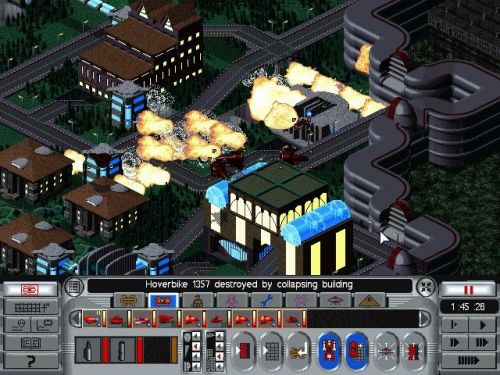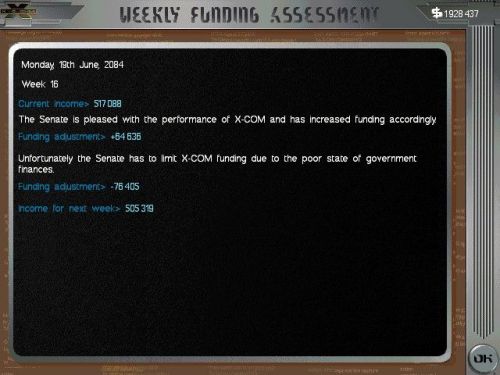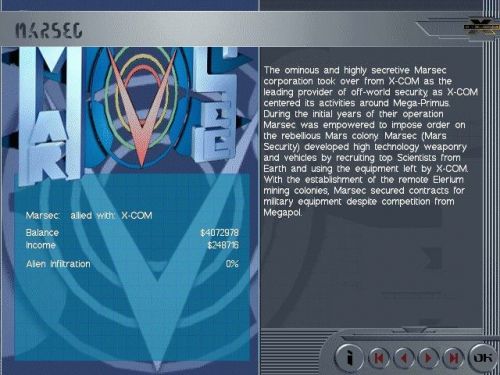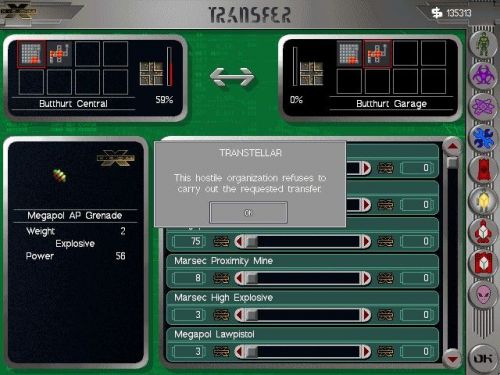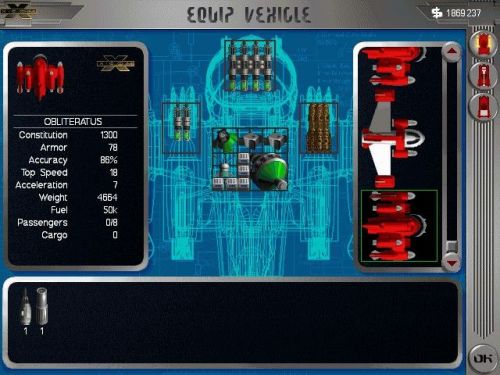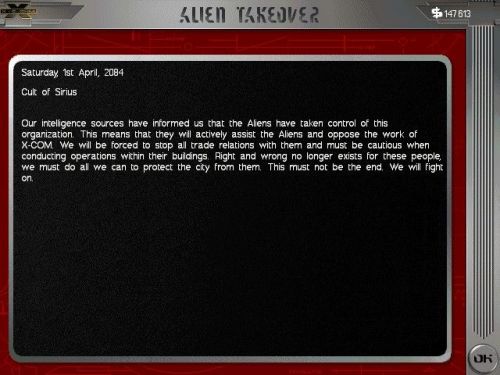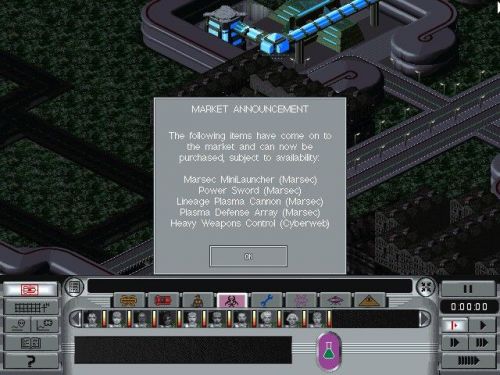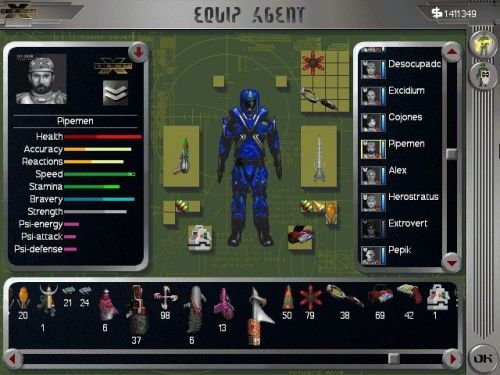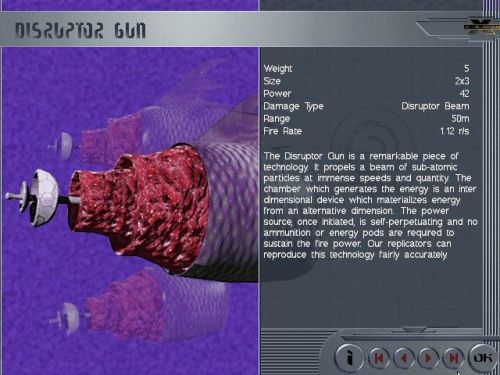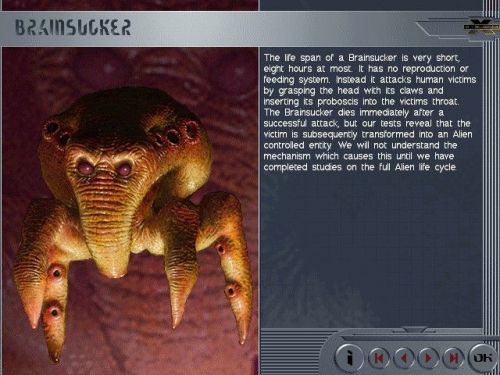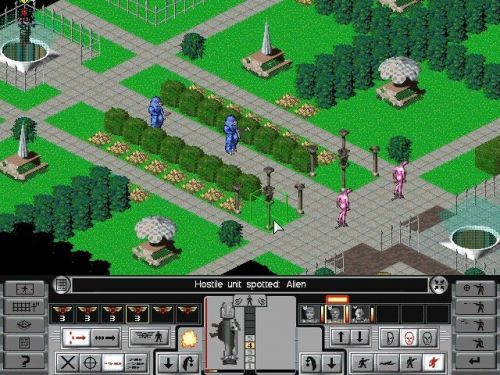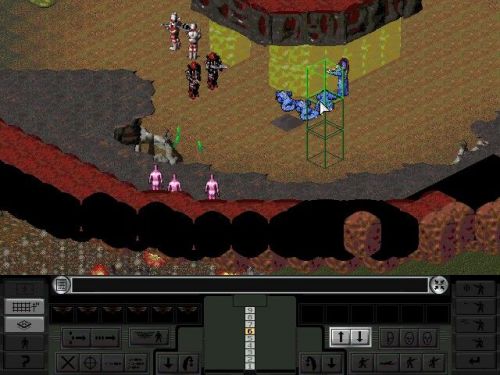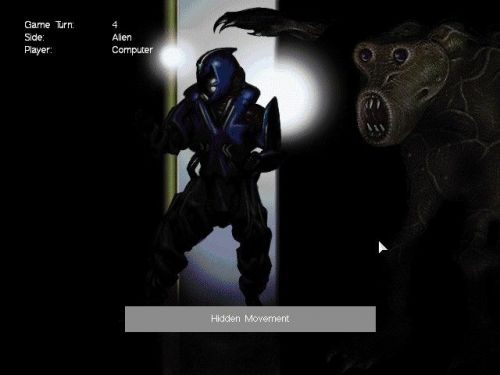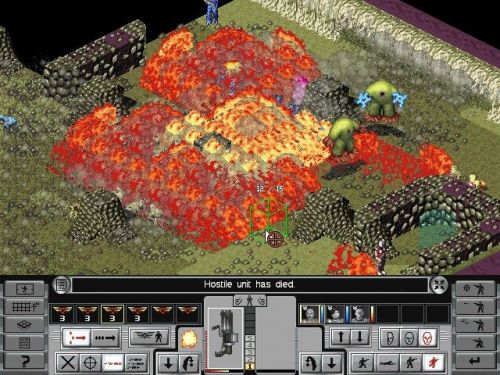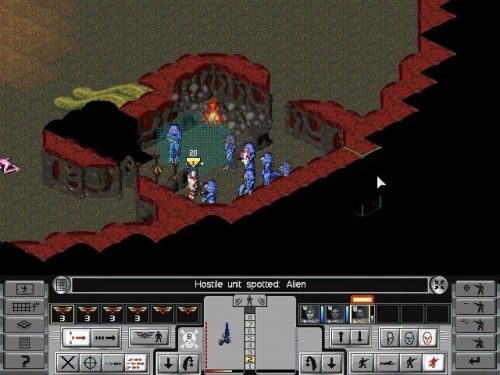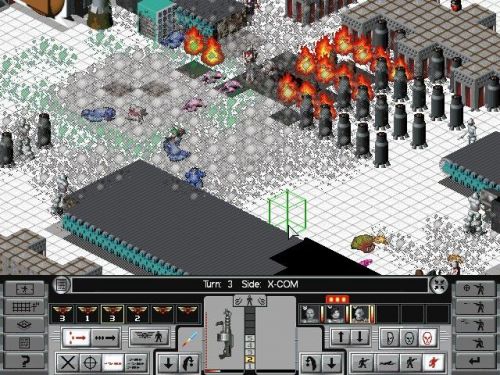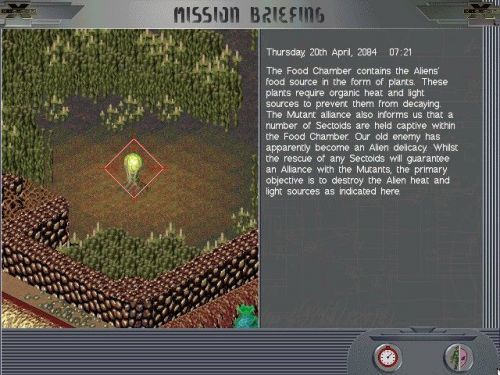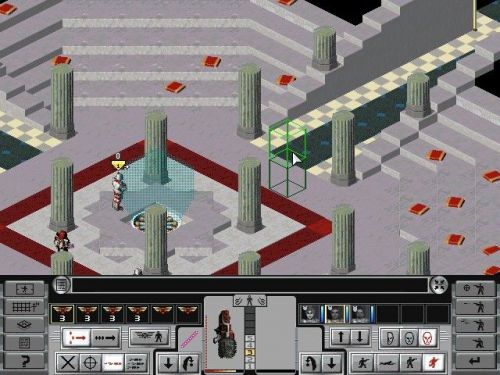TC Retrospective: X-COM: Apocalypse
TC Retrospective: X-COM: Apocalypse
Codex Review - posted by Whisky on Sat 18 July 2015, 17:42:03
Tags: MicroProse; Mythos Games; X-COM: ApocalypseLocal Strategy Game expert and veteran potato farmer Darth Roxor has taken it upon himself to do a retrospective of the ever-controversial X-COM Apocalypse. But was it really as bad as people make it out to be? Let's see what he has to say.
Hey! Do you know X-COM Apocalypse? Of course you do. It’s that bad rtwp game that killed the X-COM series and gave way to horrible games like Enforcer and Interceptor.
But a much more important question that I would like to ask you today is whether you have actually played Apocalypse. I suspect the most common answer to this will be “no”. I can’t say I blame you. After all, it took me over 15 years to gather the courage to do it myself. I was put off by so many things that I’d heard about it – that it was buggy, unstable, unfinished, nigh-impossible to run, outright bad, etc. For a longer while, I was even certain that it only featured rtwp combat, even though the turn-based mode is still there. But what I found suspicious was just how vague all of that sounded - it felt like Apocalypse was branded as a terrible game simply because it crashed a lot. So after figuring I might as well finally take the plunge, I picked it up at Gaben’s trinket shop (“hey, if it’s on Steam, that should mean it’s playable now!”) and once again took command of X-COM to stop the gosh darn aliens from stealing my freedoms. And I ended up glued to my computer for a whole month.
Read the full article: TC Retrospective: X-COM: Apocalypse
Hey! Do you know X-COM Apocalypse? Of course you do. It’s that bad rtwp game that killed the X-COM series and gave way to horrible games like Enforcer and Interceptor.
But a much more important question that I would like to ask you today is whether you have actually played Apocalypse. I suspect the most common answer to this will be “no”. I can’t say I blame you. After all, it took me over 15 years to gather the courage to do it myself. I was put off by so many things that I’d heard about it – that it was buggy, unstable, unfinished, nigh-impossible to run, outright bad, etc. For a longer while, I was even certain that it only featured rtwp combat, even though the turn-based mode is still there. But what I found suspicious was just how vague all of that sounded - it felt like Apocalypse was branded as a terrible game simply because it crashed a lot. So after figuring I might as well finally take the plunge, I picked it up at Gaben’s trinket shop (“hey, if it’s on Steam, that should mean it’s playable now!”) and once again took command of X-COM to stop the gosh darn aliens from stealing my freedoms. And I ended up glued to my computer for a whole month.
Read the full article: TC Retrospective: X-COM: Apocalypse
[Review by Darth Roxor]
Local Strategy Game expert and veteran potato farmer Darth Roxor has taken it upon himself to do a retrospective of the ever-controversial X-COM Apocalypse. But was it really as bad as people make it out to be? Let's see what he has to say.
Hey! Do you know X-COM Apocalypse? Of course you do. It’s that bad rtwp game that killed the X-COM series and gave way to horrible games like Enforcer and Interceptor.
But a much more important question that I would like to ask you today is whether you have actually played Apocalypse. I suspect the most common answer to this will be “no”. I can’t say I blame you. After all, it took me over 15 years to gather the courage to do it myself. I was put off by so many things that I’d heard about it – that it was buggy, unstable, unfinished, nigh-impossible to run, outright bad, etc. For a longer while, I was even certain that it only featured rtwp combat, even though the turn-based mode is still there. But what I found suspicious was just how vague all of that sounded - it felt like Apocalypse was branded as a terrible game simply because it crashed a lot. So after figuring I might as well finally take the plunge, I picked it up at Gaben’s trinket shop (“hey, if it’s on Steam, that should mean it’s playable now!”) and once again took command of X-COM to stop the gosh darn aliens from stealing my freedoms. And I ended up glued to my computer for a whole month.
I keep the country clean
What should perhaps be mentioned first here is that Apocalypse is a game very different from its predecessors. Whereas Terror from the Deep was basically just a reskin of Enemy Unknown, Apocalypse overhauls just about everything you could think of, and the sheer volume of new features can even be overwhelming initially.
For starters, the geoscape of EU/TftD has been replaced by a “cityscape”, and the entire gameworld is composed of only one city – glorious dystopian Mega-Primus, a metropolis housing corporations, mutants, androids, cultists and futuristic football arenas. The reason for this is that, following the destruction of T’leth in TftD, the atmosphere of Earth has become extremely toxic, making the planet inhospitable. Most of mankind has embarked to colonise space, but a part stayed behind and constructed Mega-Primus, the last bastion of humanity on Earth. But now, in 2084, this very bastion is under attack by yet another alien threat, unrelated to the previous ones, but also much more dangerous – these new aliens come from a different dimension and perform hit’n’run strikes on Mega-Primus through interdimensional gates that keep popping out of nowhere.
The cool thing about the cityscape is that despite being smaller in scale, it adds loads of new layers of management and gameplay. After all, on a fundamental level, the prequels’ geoscape was mostly about just dropping down global radar coverage and shooting down UFOs to keep the money flowing. There was no contact with the funding countries to speak of, the map was only there to track a bunch of Xs and squares, etc.
Meanwhile in Apocalypse, the whole city is your little playground of horrors. It has buildings owned by various factions, neutral vehicles flying around, taxis, transport tubes and roads. And all of these are destructible. Indeed, Mega-Primus feels alive, as opposed to just being a strategic map, simply because you can blow it all to kingdom come, even if most of the destroyed infrastructure gets rebuilt in time. But your relations with all the factions in the city sure as hell don’t.
Indeed, other inhabitants of Earth are no longer just $$$ numbers that go up and down based on alien activity, they are actual players in the world. There are 25 organisations in total that X-COM can ally or go to war with, all of them have hidden diplomacy relations with other factions (positive, neutral or negative), available funds and income levels, and each of them risks getting infiltrated by aliens. Generally speaking, there are more ways in which you can piss someone off than make him happy. While some, like the government (which is your only funding body in this game) or the police, will stay happy as long as you take down UFOs (because they are considered ‘hostile’ to aliens), some others are actually marked as ‘prone to infiltration’ and will become angry if you do your damn job. Doing collateral damage to the city is also frowned upon by many, and that aspect is unavoidable, so, again, you are bound to anger people just through intercepting UFOs. Fortunately, everyone has his price, and a well-timed bribe will make all ills come to pass.
Factions have 5 states of relations with X-COM, from allied to hostile. It is generally a good idea not to maintain too many hostilities, particularly with more aggressive groups like gangsters, because a hostile faction will not only cease all trade activity with you, but will also periodically assault your bases. But, on the other hand, enemies make for an excellent secondary source of income if you are running a tight budget because you can also raid their buildings, destroy as much inside to cripple their economies, grab any loot you can find and get out. Thanks to this, you can even do a full “rogue” playthrough and go up against not just the aliens but also the city itself. The senate blocked your funding? Maybe it’s time to go there and take it yourself! It is hellishly difficult to win in this scenario, but the fact alone that you are given such an option is nothing less than amazing.
Unfortunately, holes start appearing in the system once you discover just how many of the organisations are actually expendable. Better relations with a faction mean upholding their services and getting a higher quantity of goods you can buy from them on the market, whether it’s fuel, soldiers or guns, but out of the 25, 13 don’t produce anything, making them nothing more than magnets for alien infiltration. Furthermore, the entire diplomatic layer of the game rather quickly degenerates into a bribery simulator, since bribes are the only reliable ways of improving relations, and peddling alien artifacts quickly gets you enough cash to keep every faction right where you want it to be (although putting alien guns on the market gives hostile factions the opportunity to buy them and use them against you!). It’s quite obvious that the diplomacy in Apocalypse was meant to be much deeper, but it probably was the first thing that ended up on the chopping block during the game’s troubled development.
But enough about other people, let’s talk about your merry men and women. Basebuilding in Apocalypse is also different than in the prequels, for a variety of reasons. First, you are technically not forced to have multiple bases, because there is no radar coverage in the game, you always detect all UFOs. Second, you can’t build new bases anywhere you want, only in preset abandoned buildings (with differing construction space layouts!). Third, there are less buildings to construct in your base than in the prequels, but, in turn, many of them are hangar-sized and require more spatial planning. And finally, all the facilities like living quarters, laboratories, etc, can hold less items and personnel than before, and some others like training rooms and hangars drop in efficiency if they are overcrowded, which, down the line, forces you to set up auxiliary garages and barracks all over the city.
Research has also been slightly redesigned. The laboratories of old have been split into bio-labs and quantum research labs, again forcing you to hire more personnel, build more living quarters and more research stations (which are eventually also replaced by 4x4-sized ones that are needed to analyse more complex things). And yet another neat thing about this is that all the scientists and engineers also appear during base raids and require protection, again reinforcing the need for clever spatial planning.
Some of the most significant changes that happened to the strategic layer also concern UFO interception, and I’d say there is almost nothing but cool stuff to be had here. While in EU/TftD you were more or less okay as long as you had a small handful of aircraft with ultimate cannons for all interceptions to go flawlessly, in Apocalypse you need to have a whole fleet of varied vehicles and guns. This is mostly because when the UFOs appear, they appear all over the map, in large numbers (even up to 8 craft) and have various missions (dropships, escort vessels and bombers). To fight off these incursions or force them to retreat, you’ll need a mixed force of heavy hitters and little stingers, and you will need to balance your arsenal so as to not blow up half the city along with the aliens.
Apocalypse gives you tons of customisation when it comes to vehicles, both in terms of types and armaments. You start with an array of hoverbikes, hovercadillacs, traditional interceptors and ground vehicles like tanks, cars and APCs, but your research will eventually let you construct powerful interdimensional aircraft as well. Every vehicle also has its own set of hardpoints in various shapes and sizes that can be outfitted with cannons, engines and utility modules. You already start with a wide selection of laser and plasma cannons, and a few missile launchers, including a single-fire fusion missile excellent for levelling buildings. Engines mostly follow a linear progression of weight, cost and power, while utility modules are split between those useful in combat and for dropship duties. Combat modules include shield generators, missile jammers, stealth fields, accuracy mods, etc, while carrier modules can be installed to give a vehicle additional gear, passenger and alien containment capacity. Should you wish to do so, you can even outfit an interdimensional bus available later in the game with nothing but passenger modules and send a total of 36 X-COM agents into combat. Or buy a fleet of a few dozen hoverbikes with rocket launchers if you value Soviet infantry tactics.
The only stinker here is that ground vehicles are for the most part completely useless. They can travel only on roads, are slow as hell and get instantly destroyed if the road under them collapses or if they get hit by rubble from damaged buildings.
The actual ship combat is also no longer the EU/TftD minigame. When UFOs appear over Mega-Primus, you have to send your vehicles to intercept them, and then everything dukes it out in a glorious battle royal that results in your fighters twitching like mad in an attempt to evade enemy fire while shooting their own guns, the UFOs trying to do their jobs and getting the hell out, and the surrounding countryside being burnt to cinders. You also have to prioritise when choosing targets. Dropship UFOs are mostly pushovers in combat, but they will attempt to drop aliens into as many buildings as possible. Escort ships are usually heavy hitters that will immediately engage your fighters when they leave base. Bombers go wild on the city and attempt to do as much infrastructure damage as possible, which, paradoxically enough, is something you should allow them to do because it will harm the alien-human “diplomatic relations” and give you new allies.
You also have to closely observe where the alien dropships deploy their troops and then investigate the buildings with agents. You usually get a delayed alert about alien sightings, but not always – sometimes you will only see that an organisation has been infiltrated in the relevant menu, and then you will have to scout the buildings blindly if you didn’t pay attention to the UFO activity, and trying to investigate a non-infiltrated building harms your relations with its owner. But that is much preferable to full infiltration. Once a faction gets infiltrated over 50% by the aliens, it will turn irreversibly hostile to X-COM and the rest of Mega-Primus.
As the game goes on, the aliens deploy more and bigger UFOs armed with even deadlier weapons to oppose you. But by far the coolest thing in Apocalypse is that eventually you get to develop your very own interdimensional craft, and then the tables turn completely. Suddenly, it is you who is the invader, making incursions into the alien dimension, shooting down defending UFOs and deploying your agents on sabotage operations within the alien city. Each of these spec ops is a unique mission with its own tileset and objective that ends up with the destruction of the invaded building, and stomping the alien city into the ground is the only way to win the game.
Troubleshooters
Once a UFO is taken down, it’s time to put your boots on the ground. The tactical layer of Apocalypse has no less differences than the strategic one, but here we can find a few more questionable changes.
The agent and equipment selection in the game mirrors that of the interceptors. Once again, Apocalypse gives you a hell of a lot of options, many available right from the start, and even more coming along as you play and research new technologies.
For starters, X-COM agents now come in three types – grunts, human-sectoid hybrids and androids. Grunts have decent starting combat stats, but very poor psychic potential. They are just run of the mill soldiers. Hybrids, on the other hand, have terrible combat stats, but they are the only units that can reliably use psionics. The trick here is that, unlike in the prequels, it is not as easy to raise both mental and physical stats, since most improvement comes from different training facilities in your bases, not combat, so it is not really feasible to have a squad of psychic ubermenschen anymore. The third unit type, the android, starts with very high combat stats and counts as a psychic null (100% defence but 0 skill), but, on the flipside, it can’t improve its statistics.
In an ideal world, you’d be mixing your teams with units of many types, or you’d even set up kill teams of nothing but androids to tackle Ethereal-like aliens. Reality is unfortunately much more bleak, mainly because of the way Apocalypse neutered psionics. In some ways, the fixes are great: you can no longer really have an omni-psi team, not all aliens can be affected by psionics, making it more like an asset and less like a superweapon, and the psykers can no longer possess targets from any place on the map – they require a line of sight now, which makes it more risky for the player, and less blatantly cheat-like and frustrating when it comes to its use by the aliens. But by far the biggest problem here, that almost nullifies the good changes, is that you will hardly ever see the aliens use psionics. There are only two types of psychic aliens, and one is a rare pushover that only appears in the bomber-type UFO, while the other is a huge monstrosity that not only appears very late in the game, but also doesn’t come in numbers higher than 3 or so per map, and whose size makes it excellent target practice for your agents. It is a great shame because the general psionics formula in Apocalypse is easily the best in the series, but it’s really in desperate need of more psychic adversaries.
I mentioned equipment before and would like to get back to it. While in EU/TftD your rookies would start with pathetic peashooters and jumpsuits that you’d need to ditch asap to be effective, Apocalypse takes a little different approach. Right from the start, your agents have access to heavy armour (good protection but cumbersome), flying suits (less protection and weight, but can levitate), plasma pistols, laser precision rifles, rocket pistols, power swords, stun rays, and other more conventional weapons like machine guns, multi-purpose cannons and four types of grenades. The interesting thing here is that most of the starting equipment never really becomes obsolete – there is no weapon that can replace the versatility of the heavy cannon (AP/HE/IN rounds), no other armour that allows flying, no new melee weapons, etc. Even the stock machine gun stays deadly to the end due to its ridiculous rate of fire. And while obviously you will replace most guns with new ones, the neat thing is that you never really end up with a team of nothing but heavy plasmas. Diversity is very welcome and very useful, especially considering some of the agent loadouts you can come up with. Rocket pistol + power sword dual-wielding? Don’t mind if I do! Flying suit and dimension mines tactical bombing? Toxic dartgun close quarters action? Long-range alien rifles? Mind bender and plasma pistol? It’s all here, and it’s all effective and satisfying to use as hell. There’s some very obvious cut content here, as well, since every agent has two slots reserved for what seems to be implants, but there is only one kind of implant in the game, and its only use is selling it for massive $$$.
The relative better starting stats and equipment you can give your agents make Apocalypse feel a little more like a quasi Jagged Alliance than Enemy Unknown. These brave men and women are no longer just rookies that die in one hit and fumble every shot. They can take a beating, they can level a building, they can stun and abduct the whole alien infiltration force for probing. They also have some more advanced mobility, as they can run, crawl and jump, even if jumping is very limited.
It’s also worth mentioning that I think Apocalypse features a better difficulty curve and staying power than EU or TftD. TftD gets repetitive pretty fast, and also becomes very easy relatively quickly after the nail-bitingly frustrating start. EU also starts tough, then turns easier and somewhat stale, and finally gets tough again, but mostly due to the frustration caused by Ethereals and blaster bombs. Apocalypse is the complete reverse of both. Its start is suspiciously easy, easy enough, in fact, to make you complacent. But then, for a very large chunk of the game, it keeps introducing new hurdles for you to overcome, and the interesting thing is that these difficulties don’t really arise from new aliens, but from new alien wargear. For the most part, you keep fighting the same aliens, but it doesn’t really bother you all that much due to how their loadouts evolve – from brainsucker launchers and pistols, the aliens then start packing rifles, rocket launchers, mines, living grenades, acid launchers that melt your agents’ gear, cloaking fields, shield generators and even personal teleporters. The cityscape difficulty is also much greater than in the prequels, since UFO interception in those used to be just a banal necessity. In Apocalypse, you can only rest on your laurels in the very endgame sections, when you’ve researched everything there is and armed your veteran agents to the teeth, and when you’ve set up an interdimensional fleet that can wipe out the entire alien invasion force before it even reaches Mega-Primus.
There are a few big problems with Apocalypse’s aliens, though. First, they are simply boring. They don’t really have any shared theme. They are anything but menacing, but they aren’t even goofy, either, they are just generic as hell. Think of the bizarre monstrosities like the floaters, chryssalids and tentaculats, or the cartoony sectoids and ethereals, and now contrast them with Apocalypse’s posse: small worm, big worm, blue humanoid, yellow humanoid, green ooze, headcrab, etc. There’s nothing here that makes you think ‘whoa, that’s cool’ or ‘shit, this looks like trouble’. Just about the only alien that I think is sorta funny is a two-legged dog that goes allah akbar on your troopers’ asses.
Second, a few of them are annoying as hell. Take the multiworm. It’s a hp-bloated vagina dentata with an acid spit attack. It has the 3rd highest alien health count in the game, but can be encountered from the very start. The only way you can reliably eliminate those without shooting them from afar for half an hour is spraying them with autofire from point blank. But the trick is that these shits spawn 4 little hyperworms on death, and those buggers appear with full time unit pools and high reactions, meaning the next action your agent takes will likely result in his instant death.
Third, the aliens no longer have different ranks, like medic, navigator, etc. While this doesn’t cripple enemy diversity as much, because of the aforementioned variety in loadouts, it does hurt research and combat objectives a bit because you are no longer expected to keep capturing live aliens. Once you’ve captured one, all the others of its kind are fair game.
Goodness gracious, I’ve talked so much about the stuff surrounding the combat, but nothing about combat itself. Guess it’s time to address that.
Once you’ve outfitted your agents (loadouts are saved between missions, which is a godsend) and loaded them up on a dozen hoverbikes, it’s finally time to sniff out the alien scum. Before the actual mission starts, you can also assign your agents into squads. This is mostly for convenience, but every squad also spawns in a different entry point on the map, eliminating the threat of a grenade hitting your skyranger on landing.
But that’s not all! You also get to choose whether you want to play in turn-based or real time with pause modes!
I will start with the rtwp mode because it’s faster to get over with. The decision to include it feels completely bizarre to me, especially since it plays exactly like you’d expect. It’s inferior to turn-based in just about every way, and boils down to a majestic clusterfuck where units run around wildly, bullets and missiles fly in all directions and you are left wondering just what the hell is going on. Its only (comedic) application is to arm all your dudes with ammo-less energy weapons and proceed to level the map by shooting up every building in the vicinity.
Now, turn-based, that’s where all the fun is at. The core is not that different from the prequels – all characters have time units, there’s reaction fire, firing modes with different accuracy and TU cost, etc. But the dynamics of Apocalypse’s combat were changed so much it feels completely unlike its predecessors. This is mostly due to the TU costs of shooting and how reactions are handled.
While your agents still have TU pools that go up from 50, the shooting costs have been scaled down immensely, and autofire no longer counts as burst, but instead as single bullets shot at minimum cost and accuracy. Indeed, shooting, for example, a heavy weapon like an autocannon requires: 1/3 TU for aimed shot, 1/6 for snap shot, 1/12 for autoshot. Even better, rapid fire weapons like machine guns or dartguns go down even to 1 TU per bullet on autofire. Your agents can now shoot a lot more than before, even after moving across half the map! The problem with this is that you can now get away with a lot more spray and pray and recklessness. Hell, by far the most effective tactic in Apocalypse is to just go full berserk and order your agents to move into point blank to spread the autofire love. With the toxic dartguns you get later in the game, it’s actually not uncommon for one agent to run into the middle of an alien mob and kill 10 enemies in quick succession. The only thing that really stops you from doing this is the fact that some aliens like to carry primed grenades around. While the chain reactions this can cause on their death are often hilarious, they are usually just as fatal for your agents.
Normally, degenerate tactics like these would get stopped by the threat of reaction fire, but this is also not the case in Apocalypse. You have to remember your agents start with good armour, so a single shot won’t bring them down. They also get personal shield generators later on, making them even more sturdy. Plus, most aliens have terrible reaction scores and TUs. And finally, reactions are not limited only to shooting anymore. There are a few AI protocols for reacting to enemy actions, and while at first it might seem impressive that a unit will interrupt another one to move behind cover or even dodge a fired shot, these TUs would often be better spent simply blowing the enemy’s head off, especially since the new reactions also permit the unit to shoot multiple times before letting an enemy act again. This happens often when you set your agents to “aggressive” mode, which prioritises shooting over movement. In these cases, a duo of agents with high reactions can unload their whole magazines in a wild shootout after spotting an alien before letting it act again.
Level design also reinforces the need for close combat. Since most missions take place in infiltrated buildings, Apocalypse completely removes the possibility of the prequels’ infamous 1 scout + 11 snipers tactic. Here, you are mostly doing tactical roomsweeps or engaging in shootouts in enclosed spaces. Even UFO recovery maps are all about close quarters, since the downed ships take up the entirety of the maps, and no aliens ever move out to prowl the countryside.
Mission design and structure is also a bit of a mixed bag. The big problem here is that there are no terror missions, alien bases, not even night missions. In theory, every counter-infiltration is a “terror” mission because there are always civilians cluelessly running around. But the aliens don’t ever target them. They are only there as bait for collateral damage. On the other hand, the amount of available tilesets for different building types is pretty impressive, which keeps the game from getting too stale, even if many of them are limited in terms of randomisation, and many maps will simply become predictable down the line.
The last thing that I would like to mention in this chapter is what Apocalypse is probably known for the best – the tacticool terrain destruction. You can destroy everything in Apocalypse. Every. Single. Thing. You can even bring down whole floors and buildings with enough ordnance. Often, when you see many aliens hiding in a tall glass tower, it is much easier to just plant explosives at its base and watch it all collapse. You can also do some shenanigans like blow away the floor from under an alien and watch the rubble fall and kill another one below while the first one crashes to its death against the pavement. The degree of destruction in Apocalypse is simply unmatched, and the way it opens up so many options in gameplay is astounding. Every map is a sandbox castle just waiting to be hit by a passing brick. You shouldn’t really nuke every level, though, because the more environmental damage you do, the more you will harm your relations with the building’s owner. On the other hand, if its an enemy faction, you are very much encouraged to do as much damage as possible to cripple its economy.
The Mega-Primus Blues
Quite unfortunately, most of what people say about Apocalypse’s technical state is still very true. Even getting the Steam version to run properly still required some fiddling with the “preconfigured” Dosbox settings to set things right.
The game also really loves to crash, although for some reason only in fullscreen, and only at mission end. It is therefore highly advised not to play ironman, and save very often in many slots, preferably right before killing the final alien in each mission, too. Sometimes it also tends to bug out during mission loading where it will tell you to put the game CD back into the drive.
It also still has plenty of bugs, although, fortunately, many of them you can quickly identify and evade. By far the most annoying one is when you end a running agent’s turn when he runs out of TU before reaching his destination – it’ll cause him to be stuck in permanent walking mode, doubling his movement costs.
It also has to be said that Apocalypse is not a very pretty game. While the retro sci-fi/art nouveau design mix of Mega-Primus is certainly a great idea, the way it’s realised in the game feels sorely lacking. The level tilesets and props are blocky and badly detailed, the alien graphic and conceptual design is terrible, and everything feels much too “clean” and generic. The comic-book aesthetics of EU and TftD are almost completely gone. Although there are some moments of brilliance to be had here, like the hovercadillacs, or the alien-worshipping lunatics of the Cult of Sirius who run around in little green men rubber suits. There are also some problems with scale, especially when you compare the sizes of downed UFOs on the cityscape and on the battle maps. Mega-Primus itself is also weird, considering it’s supposed to be your typical cyberpunk sprawl, but when you think about it, it’s not really bigger than a housing estate.
Most of the music comes once again from John Broomhall, the same chap who did the soundtracks for EU and TftD, so expect lots of spooky ambient howls and beep boops. However, Apocalypse also has a bunch of industrial-ish tracks, mostly combat music, with heavily distorted guitars, sounds of machinery, etc, that are facemeltingly awesome if you are into that sort of style. Just search youtube or whatever for the aptly titled track #22 – Kill Them All. The mix of overdriven guitars with an effect emulating furious picking, the drums, the crane sounds, the spooky howls and the alarm sirens has made the tune instantly jump into my list of favourite soundtracks. That’s right, half of this paragraph is about one song. Because it’s just that good.
Remember the fallen
The conclusion to this review will be a bit longer than usual, but I have a few final thoughts that I would like to put here, and which didn’t really fit in the previous chapters.
First, X-COM Apocalypse, standing on its own, is a proud testament to its developers ambitions, even if, unfortunately, it would turn out to be their swansong. It is quite obvious that Mythos Games wanted to make Apocalypse the ultimate X-COM game, which would expand on everything that was set up in the previous two games, instead of just building another rehash of Enemy Unknown, just like it was in the case of Terror from the Deep. The changes to the strategic layer, even if many of them are clearly unfinished, give the cityscape a lot of very needed player agency and management. The changes to the tactical layer remove many of the originals’ flaws and frustrations in excellent and elegant ways, just a shame that they replace some of the problems with new ones of their own. Apocalypse, to me, felt like an X-COM game++. An X-COM game reinforced by ideas found in 4x strategies and other tactical games such as Jagged Alliance, but also by some original formulas as well. A great recipe to be sure. Unfortunately, one which would also overwhelm the developers because of its sheer scale. Yet even with cut corners and half-implemented ideas, Apocalypse nevertheless remains a great game that, to me, is as good as Enemy Unknown, despite the fact that they also feel almost completely different. But Apocalypse was still made in those glorious times when a game’s sequel was expected to improve on its predecessor and add new things or change the core design without losing the game’s spirit. And it just makes me incredibly sad when I think about what Apocalypse could have been if it had been fully realised.
If I had to draw a very long-distance parallel between Apocalypse and another game, I would have to name Heroes of Might and Magic IV as a similar case. The comparisons practically name themselves – both are entries in cult series that would apply many changes to the core formulas, most of which would be hit-and-miss, both of them had very troubled development cycles, and both of them have been forgotten by most people out there when it comes to their actual gameplay. The only memories that are left of these two are vague comments such as “the graphics suck”, “it changed too much”, “now that was a terrible game”. And even though I personally like HoMM4, it definitely deserved a lot of its flak. But I simply don’t believe that is the case with Apocalypse.
What is perhaps even more depressing, regarding the above deliberations, is that most of HoMM4’s “good” ideas actually made it into its sequel. But Apocalypse has been left forgotten. You don’t really see any of its heritage in a game like Xenonauts, which, while an excellent game to be sure, especially after the long X-COM drought, is just the kind of EU rehash I’ve talked about above. It doesn’t even try to take Apocalypse’s diplomacy, equipment diversity, environmental destruction, anything. Instead, it even goes ahead and further breaks some of EU’s problems, like psionics, while it could look to Apocalypse for inspiration regarding how it should be done.
And then, naturally, we have the Firaxis XCOM games, whose designers I can hardly even imagine playing a game like Apocalypse in the first place. After all, hey, it was that bad rtwp game that killed the X-COM series and gave way to horrible games like Enforcer and Interceptor. Why would anyone ever try to revisit such a broken, shitty old game in this brave new world?
Local Strategy Game expert and veteran potato farmer Darth Roxor has taken it upon himself to do a retrospective of the ever-controversial X-COM Apocalypse. But was it really as bad as people make it out to be? Let's see what he has to say.
Hey! Do you know X-COM Apocalypse? Of course you do. It’s that bad rtwp game that killed the X-COM series and gave way to horrible games like Enforcer and Interceptor.
But a much more important question that I would like to ask you today is whether you have actually played Apocalypse. I suspect the most common answer to this will be “no”. I can’t say I blame you. After all, it took me over 15 years to gather the courage to do it myself. I was put off by so many things that I’d heard about it – that it was buggy, unstable, unfinished, nigh-impossible to run, outright bad, etc. For a longer while, I was even certain that it only featured rtwp combat, even though the turn-based mode is still there. But what I found suspicious was just how vague all of that sounded - it felt like Apocalypse was branded as a terrible game simply because it crashed a lot. So after figuring I might as well finally take the plunge, I picked it up at Gaben’s trinket shop (“hey, if it’s on Steam, that should mean it’s playable now!”) and once again took command of X-COM to stop the gosh darn aliens from stealing my freedoms. And I ended up glued to my computer for a whole month.
I keep the country clean
What should perhaps be mentioned first here is that Apocalypse is a game very different from its predecessors. Whereas Terror from the Deep was basically just a reskin of Enemy Unknown, Apocalypse overhauls just about everything you could think of, and the sheer volume of new features can even be overwhelming initially.
For starters, the geoscape of EU/TftD has been replaced by a “cityscape”, and the entire gameworld is composed of only one city – glorious dystopian Mega-Primus, a metropolis housing corporations, mutants, androids, cultists and futuristic football arenas. The reason for this is that, following the destruction of T’leth in TftD, the atmosphere of Earth has become extremely toxic, making the planet inhospitable. Most of mankind has embarked to colonise space, but a part stayed behind and constructed Mega-Primus, the last bastion of humanity on Earth. But now, in 2084, this very bastion is under attack by yet another alien threat, unrelated to the previous ones, but also much more dangerous – these new aliens come from a different dimension and perform hit’n’run strikes on Mega-Primus through interdimensional gates that keep popping out of nowhere.
The cool thing about the cityscape is that despite being smaller in scale, it adds loads of new layers of management and gameplay. After all, on a fundamental level, the prequels’ geoscape was mostly about just dropping down global radar coverage and shooting down UFOs to keep the money flowing. There was no contact with the funding countries to speak of, the map was only there to track a bunch of Xs and squares, etc.
Meanwhile in Apocalypse, the whole city is your little playground of horrors. It has buildings owned by various factions, neutral vehicles flying around, taxis, transport tubes and roads. And all of these are destructible. Indeed, Mega-Primus feels alive, as opposed to just being a strategic map, simply because you can blow it all to kingdom come, even if most of the destroyed infrastructure gets rebuilt in time. But your relations with all the factions in the city sure as hell don’t.
Indeed, other inhabitants of Earth are no longer just $$$ numbers that go up and down based on alien activity, they are actual players in the world. There are 25 organisations in total that X-COM can ally or go to war with, all of them have hidden diplomacy relations with other factions (positive, neutral or negative), available funds and income levels, and each of them risks getting infiltrated by aliens. Generally speaking, there are more ways in which you can piss someone off than make him happy. While some, like the government (which is your only funding body in this game) or the police, will stay happy as long as you take down UFOs (because they are considered ‘hostile’ to aliens), some others are actually marked as ‘prone to infiltration’ and will become angry if you do your damn job. Doing collateral damage to the city is also frowned upon by many, and that aspect is unavoidable, so, again, you are bound to anger people just through intercepting UFOs. Fortunately, everyone has his price, and a well-timed bribe will make all ills come to pass.
Factions have 5 states of relations with X-COM, from allied to hostile. It is generally a good idea not to maintain too many hostilities, particularly with more aggressive groups like gangsters, because a hostile faction will not only cease all trade activity with you, but will also periodically assault your bases. But, on the other hand, enemies make for an excellent secondary source of income if you are running a tight budget because you can also raid their buildings, destroy as much inside to cripple their economies, grab any loot you can find and get out. Thanks to this, you can even do a full “rogue” playthrough and go up against not just the aliens but also the city itself. The senate blocked your funding? Maybe it’s time to go there and take it yourself! It is hellishly difficult to win in this scenario, but the fact alone that you are given such an option is nothing less than amazing.
Unfortunately, holes start appearing in the system once you discover just how many of the organisations are actually expendable. Better relations with a faction mean upholding their services and getting a higher quantity of goods you can buy from them on the market, whether it’s fuel, soldiers or guns, but out of the 25, 13 don’t produce anything, making them nothing more than magnets for alien infiltration. Furthermore, the entire diplomatic layer of the game rather quickly degenerates into a bribery simulator, since bribes are the only reliable ways of improving relations, and peddling alien artifacts quickly gets you enough cash to keep every faction right where you want it to be (although putting alien guns on the market gives hostile factions the opportunity to buy them and use them against you!). It’s quite obvious that the diplomacy in Apocalypse was meant to be much deeper, but it probably was the first thing that ended up on the chopping block during the game’s troubled development.
But enough about other people, let’s talk about your merry men and women. Basebuilding in Apocalypse is also different than in the prequels, for a variety of reasons. First, you are technically not forced to have multiple bases, because there is no radar coverage in the game, you always detect all UFOs. Second, you can’t build new bases anywhere you want, only in preset abandoned buildings (with differing construction space layouts!). Third, there are less buildings to construct in your base than in the prequels, but, in turn, many of them are hangar-sized and require more spatial planning. And finally, all the facilities like living quarters, laboratories, etc, can hold less items and personnel than before, and some others like training rooms and hangars drop in efficiency if they are overcrowded, which, down the line, forces you to set up auxiliary garages and barracks all over the city.
Research has also been slightly redesigned. The laboratories of old have been split into bio-labs and quantum research labs, again forcing you to hire more personnel, build more living quarters and more research stations (which are eventually also replaced by 4x4-sized ones that are needed to analyse more complex things). And yet another neat thing about this is that all the scientists and engineers also appear during base raids and require protection, again reinforcing the need for clever spatial planning.
Some of the most significant changes that happened to the strategic layer also concern UFO interception, and I’d say there is almost nothing but cool stuff to be had here. While in EU/TftD you were more or less okay as long as you had a small handful of aircraft with ultimate cannons for all interceptions to go flawlessly, in Apocalypse you need to have a whole fleet of varied vehicles and guns. This is mostly because when the UFOs appear, they appear all over the map, in large numbers (even up to 8 craft) and have various missions (dropships, escort vessels and bombers). To fight off these incursions or force them to retreat, you’ll need a mixed force of heavy hitters and little stingers, and you will need to balance your arsenal so as to not blow up half the city along with the aliens.
Apocalypse gives you tons of customisation when it comes to vehicles, both in terms of types and armaments. You start with an array of hoverbikes, hovercadillacs, traditional interceptors and ground vehicles like tanks, cars and APCs, but your research will eventually let you construct powerful interdimensional aircraft as well. Every vehicle also has its own set of hardpoints in various shapes and sizes that can be outfitted with cannons, engines and utility modules. You already start with a wide selection of laser and plasma cannons, and a few missile launchers, including a single-fire fusion missile excellent for levelling buildings. Engines mostly follow a linear progression of weight, cost and power, while utility modules are split between those useful in combat and for dropship duties. Combat modules include shield generators, missile jammers, stealth fields, accuracy mods, etc, while carrier modules can be installed to give a vehicle additional gear, passenger and alien containment capacity. Should you wish to do so, you can even outfit an interdimensional bus available later in the game with nothing but passenger modules and send a total of 36 X-COM agents into combat. Or buy a fleet of a few dozen hoverbikes with rocket launchers if you value Soviet infantry tactics.
The only stinker here is that ground vehicles are for the most part completely useless. They can travel only on roads, are slow as hell and get instantly destroyed if the road under them collapses or if they get hit by rubble from damaged buildings.
The actual ship combat is also no longer the EU/TftD minigame. When UFOs appear over Mega-Primus, you have to send your vehicles to intercept them, and then everything dukes it out in a glorious battle royal that results in your fighters twitching like mad in an attempt to evade enemy fire while shooting their own guns, the UFOs trying to do their jobs and getting the hell out, and the surrounding countryside being burnt to cinders. You also have to prioritise when choosing targets. Dropship UFOs are mostly pushovers in combat, but they will attempt to drop aliens into as many buildings as possible. Escort ships are usually heavy hitters that will immediately engage your fighters when they leave base. Bombers go wild on the city and attempt to do as much infrastructure damage as possible, which, paradoxically enough, is something you should allow them to do because it will harm the alien-human “diplomatic relations” and give you new allies.
You also have to closely observe where the alien dropships deploy their troops and then investigate the buildings with agents. You usually get a delayed alert about alien sightings, but not always – sometimes you will only see that an organisation has been infiltrated in the relevant menu, and then you will have to scout the buildings blindly if you didn’t pay attention to the UFO activity, and trying to investigate a non-infiltrated building harms your relations with its owner. But that is much preferable to full infiltration. Once a faction gets infiltrated over 50% by the aliens, it will turn irreversibly hostile to X-COM and the rest of Mega-Primus.
As the game goes on, the aliens deploy more and bigger UFOs armed with even deadlier weapons to oppose you. But by far the coolest thing in Apocalypse is that eventually you get to develop your very own interdimensional craft, and then the tables turn completely. Suddenly, it is you who is the invader, making incursions into the alien dimension, shooting down defending UFOs and deploying your agents on sabotage operations within the alien city. Each of these spec ops is a unique mission with its own tileset and objective that ends up with the destruction of the invaded building, and stomping the alien city into the ground is the only way to win the game.
Troubleshooters
Once a UFO is taken down, it’s time to put your boots on the ground. The tactical layer of Apocalypse has no less differences than the strategic one, but here we can find a few more questionable changes.
The agent and equipment selection in the game mirrors that of the interceptors. Once again, Apocalypse gives you a hell of a lot of options, many available right from the start, and even more coming along as you play and research new technologies.
For starters, X-COM agents now come in three types – grunts, human-sectoid hybrids and androids. Grunts have decent starting combat stats, but very poor psychic potential. They are just run of the mill soldiers. Hybrids, on the other hand, have terrible combat stats, but they are the only units that can reliably use psionics. The trick here is that, unlike in the prequels, it is not as easy to raise both mental and physical stats, since most improvement comes from different training facilities in your bases, not combat, so it is not really feasible to have a squad of psychic ubermenschen anymore. The third unit type, the android, starts with very high combat stats and counts as a psychic null (100% defence but 0 skill), but, on the flipside, it can’t improve its statistics.
In an ideal world, you’d be mixing your teams with units of many types, or you’d even set up kill teams of nothing but androids to tackle Ethereal-like aliens. Reality is unfortunately much more bleak, mainly because of the way Apocalypse neutered psionics. In some ways, the fixes are great: you can no longer really have an omni-psi team, not all aliens can be affected by psionics, making it more like an asset and less like a superweapon, and the psykers can no longer possess targets from any place on the map – they require a line of sight now, which makes it more risky for the player, and less blatantly cheat-like and frustrating when it comes to its use by the aliens. But by far the biggest problem here, that almost nullifies the good changes, is that you will hardly ever see the aliens use psionics. There are only two types of psychic aliens, and one is a rare pushover that only appears in the bomber-type UFO, while the other is a huge monstrosity that not only appears very late in the game, but also doesn’t come in numbers higher than 3 or so per map, and whose size makes it excellent target practice for your agents. It is a great shame because the general psionics formula in Apocalypse is easily the best in the series, but it’s really in desperate need of more psychic adversaries.
I mentioned equipment before and would like to get back to it. While in EU/TftD your rookies would start with pathetic peashooters and jumpsuits that you’d need to ditch asap to be effective, Apocalypse takes a little different approach. Right from the start, your agents have access to heavy armour (good protection but cumbersome), flying suits (less protection and weight, but can levitate), plasma pistols, laser precision rifles, rocket pistols, power swords, stun rays, and other more conventional weapons like machine guns, multi-purpose cannons and four types of grenades. The interesting thing here is that most of the starting equipment never really becomes obsolete – there is no weapon that can replace the versatility of the heavy cannon (AP/HE/IN rounds), no other armour that allows flying, no new melee weapons, etc. Even the stock machine gun stays deadly to the end due to its ridiculous rate of fire. And while obviously you will replace most guns with new ones, the neat thing is that you never really end up with a team of nothing but heavy plasmas. Diversity is very welcome and very useful, especially considering some of the agent loadouts you can come up with. Rocket pistol + power sword dual-wielding? Don’t mind if I do! Flying suit and dimension mines tactical bombing? Toxic dartgun close quarters action? Long-range alien rifles? Mind bender and plasma pistol? It’s all here, and it’s all effective and satisfying to use as hell. There’s some very obvious cut content here, as well, since every agent has two slots reserved for what seems to be implants, but there is only one kind of implant in the game, and its only use is selling it for massive $$$.
The relative better starting stats and equipment you can give your agents make Apocalypse feel a little more like a quasi Jagged Alliance than Enemy Unknown. These brave men and women are no longer just rookies that die in one hit and fumble every shot. They can take a beating, they can level a building, they can stun and abduct the whole alien infiltration force for probing. They also have some more advanced mobility, as they can run, crawl and jump, even if jumping is very limited.
It’s also worth mentioning that I think Apocalypse features a better difficulty curve and staying power than EU or TftD. TftD gets repetitive pretty fast, and also becomes very easy relatively quickly after the nail-bitingly frustrating start. EU also starts tough, then turns easier and somewhat stale, and finally gets tough again, but mostly due to the frustration caused by Ethereals and blaster bombs. Apocalypse is the complete reverse of both. Its start is suspiciously easy, easy enough, in fact, to make you complacent. But then, for a very large chunk of the game, it keeps introducing new hurdles for you to overcome, and the interesting thing is that these difficulties don’t really arise from new aliens, but from new alien wargear. For the most part, you keep fighting the same aliens, but it doesn’t really bother you all that much due to how their loadouts evolve – from brainsucker launchers and pistols, the aliens then start packing rifles, rocket launchers, mines, living grenades, acid launchers that melt your agents’ gear, cloaking fields, shield generators and even personal teleporters. The cityscape difficulty is also much greater than in the prequels, since UFO interception in those used to be just a banal necessity. In Apocalypse, you can only rest on your laurels in the very endgame sections, when you’ve researched everything there is and armed your veteran agents to the teeth, and when you’ve set up an interdimensional fleet that can wipe out the entire alien invasion force before it even reaches Mega-Primus.
There are a few big problems with Apocalypse’s aliens, though. First, they are simply boring. They don’t really have any shared theme. They are anything but menacing, but they aren’t even goofy, either, they are just generic as hell. Think of the bizarre monstrosities like the floaters, chryssalids and tentaculats, or the cartoony sectoids and ethereals, and now contrast them with Apocalypse’s posse: small worm, big worm, blue humanoid, yellow humanoid, green ooze, headcrab, etc. There’s nothing here that makes you think ‘whoa, that’s cool’ or ‘shit, this looks like trouble’. Just about the only alien that I think is sorta funny is a two-legged dog that goes allah akbar on your troopers’ asses.
Second, a few of them are annoying as hell. Take the multiworm. It’s a hp-bloated vagina dentata with an acid spit attack. It has the 3rd highest alien health count in the game, but can be encountered from the very start. The only way you can reliably eliminate those without shooting them from afar for half an hour is spraying them with autofire from point blank. But the trick is that these shits spawn 4 little hyperworms on death, and those buggers appear with full time unit pools and high reactions, meaning the next action your agent takes will likely result in his instant death.
Third, the aliens no longer have different ranks, like medic, navigator, etc. While this doesn’t cripple enemy diversity as much, because of the aforementioned variety in loadouts, it does hurt research and combat objectives a bit because you are no longer expected to keep capturing live aliens. Once you’ve captured one, all the others of its kind are fair game.
Goodness gracious, I’ve talked so much about the stuff surrounding the combat, but nothing about combat itself. Guess it’s time to address that.
Once you’ve outfitted your agents (loadouts are saved between missions, which is a godsend) and loaded them up on a dozen hoverbikes, it’s finally time to sniff out the alien scum. Before the actual mission starts, you can also assign your agents into squads. This is mostly for convenience, but every squad also spawns in a different entry point on the map, eliminating the threat of a grenade hitting your skyranger on landing.
But that’s not all! You also get to choose whether you want to play in turn-based or real time with pause modes!
I will start with the rtwp mode because it’s faster to get over with. The decision to include it feels completely bizarre to me, especially since it plays exactly like you’d expect. It’s inferior to turn-based in just about every way, and boils down to a majestic clusterfuck where units run around wildly, bullets and missiles fly in all directions and you are left wondering just what the hell is going on. Its only (comedic) application is to arm all your dudes with ammo-less energy weapons and proceed to level the map by shooting up every building in the vicinity.
Now, turn-based, that’s where all the fun is at. The core is not that different from the prequels – all characters have time units, there’s reaction fire, firing modes with different accuracy and TU cost, etc. But the dynamics of Apocalypse’s combat were changed so much it feels completely unlike its predecessors. This is mostly due to the TU costs of shooting and how reactions are handled.
While your agents still have TU pools that go up from 50, the shooting costs have been scaled down immensely, and autofire no longer counts as burst, but instead as single bullets shot at minimum cost and accuracy. Indeed, shooting, for example, a heavy weapon like an autocannon requires: 1/3 TU for aimed shot, 1/6 for snap shot, 1/12 for autoshot. Even better, rapid fire weapons like machine guns or dartguns go down even to 1 TU per bullet on autofire. Your agents can now shoot a lot more than before, even after moving across half the map! The problem with this is that you can now get away with a lot more spray and pray and recklessness. Hell, by far the most effective tactic in Apocalypse is to just go full berserk and order your agents to move into point blank to spread the autofire love. With the toxic dartguns you get later in the game, it’s actually not uncommon for one agent to run into the middle of an alien mob and kill 10 enemies in quick succession. The only thing that really stops you from doing this is the fact that some aliens like to carry primed grenades around. While the chain reactions this can cause on their death are often hilarious, they are usually just as fatal for your agents.
Normally, degenerate tactics like these would get stopped by the threat of reaction fire, but this is also not the case in Apocalypse. You have to remember your agents start with good armour, so a single shot won’t bring them down. They also get personal shield generators later on, making them even more sturdy. Plus, most aliens have terrible reaction scores and TUs. And finally, reactions are not limited only to shooting anymore. There are a few AI protocols for reacting to enemy actions, and while at first it might seem impressive that a unit will interrupt another one to move behind cover or even dodge a fired shot, these TUs would often be better spent simply blowing the enemy’s head off, especially since the new reactions also permit the unit to shoot multiple times before letting an enemy act again. This happens often when you set your agents to “aggressive” mode, which prioritises shooting over movement. In these cases, a duo of agents with high reactions can unload their whole magazines in a wild shootout after spotting an alien before letting it act again.
Level design also reinforces the need for close combat. Since most missions take place in infiltrated buildings, Apocalypse completely removes the possibility of the prequels’ infamous 1 scout + 11 snipers tactic. Here, you are mostly doing tactical roomsweeps or engaging in shootouts in enclosed spaces. Even UFO recovery maps are all about close quarters, since the downed ships take up the entirety of the maps, and no aliens ever move out to prowl the countryside.
Mission design and structure is also a bit of a mixed bag. The big problem here is that there are no terror missions, alien bases, not even night missions. In theory, every counter-infiltration is a “terror” mission because there are always civilians cluelessly running around. But the aliens don’t ever target them. They are only there as bait for collateral damage. On the other hand, the amount of available tilesets for different building types is pretty impressive, which keeps the game from getting too stale, even if many of them are limited in terms of randomisation, and many maps will simply become predictable down the line.
The last thing that I would like to mention in this chapter is what Apocalypse is probably known for the best – the tacticool terrain destruction. You can destroy everything in Apocalypse. Every. Single. Thing. You can even bring down whole floors and buildings with enough ordnance. Often, when you see many aliens hiding in a tall glass tower, it is much easier to just plant explosives at its base and watch it all collapse. You can also do some shenanigans like blow away the floor from under an alien and watch the rubble fall and kill another one below while the first one crashes to its death against the pavement. The degree of destruction in Apocalypse is simply unmatched, and the way it opens up so many options in gameplay is astounding. Every map is a sandbox castle just waiting to be hit by a passing brick. You shouldn’t really nuke every level, though, because the more environmental damage you do, the more you will harm your relations with the building’s owner. On the other hand, if its an enemy faction, you are very much encouraged to do as much damage as possible to cripple its economy.
The Mega-Primus Blues
Quite unfortunately, most of what people say about Apocalypse’s technical state is still very true. Even getting the Steam version to run properly still required some fiddling with the “preconfigured” Dosbox settings to set things right.
The game also really loves to crash, although for some reason only in fullscreen, and only at mission end. It is therefore highly advised not to play ironman, and save very often in many slots, preferably right before killing the final alien in each mission, too. Sometimes it also tends to bug out during mission loading where it will tell you to put the game CD back into the drive.
It also still has plenty of bugs, although, fortunately, many of them you can quickly identify and evade. By far the most annoying one is when you end a running agent’s turn when he runs out of TU before reaching his destination – it’ll cause him to be stuck in permanent walking mode, doubling his movement costs.
It also has to be said that Apocalypse is not a very pretty game. While the retro sci-fi/art nouveau design mix of Mega-Primus is certainly a great idea, the way it’s realised in the game feels sorely lacking. The level tilesets and props are blocky and badly detailed, the alien graphic and conceptual design is terrible, and everything feels much too “clean” and generic. The comic-book aesthetics of EU and TftD are almost completely gone. Although there are some moments of brilliance to be had here, like the hovercadillacs, or the alien-worshipping lunatics of the Cult of Sirius who run around in little green men rubber suits. There are also some problems with scale, especially when you compare the sizes of downed UFOs on the cityscape and on the battle maps. Mega-Primus itself is also weird, considering it’s supposed to be your typical cyberpunk sprawl, but when you think about it, it’s not really bigger than a housing estate.
Most of the music comes once again from John Broomhall, the same chap who did the soundtracks for EU and TftD, so expect lots of spooky ambient howls and beep boops. However, Apocalypse also has a bunch of industrial-ish tracks, mostly combat music, with heavily distorted guitars, sounds of machinery, etc, that are facemeltingly awesome if you are into that sort of style. Just search youtube or whatever for the aptly titled track #22 – Kill Them All. The mix of overdriven guitars with an effect emulating furious picking, the drums, the crane sounds, the spooky howls and the alarm sirens has made the tune instantly jump into my list of favourite soundtracks. That’s right, half of this paragraph is about one song. Because it’s just that good.
Remember the fallen
The conclusion to this review will be a bit longer than usual, but I have a few final thoughts that I would like to put here, and which didn’t really fit in the previous chapters.
First, X-COM Apocalypse, standing on its own, is a proud testament to its developers ambitions, even if, unfortunately, it would turn out to be their swansong. It is quite obvious that Mythos Games wanted to make Apocalypse the ultimate X-COM game, which would expand on everything that was set up in the previous two games, instead of just building another rehash of Enemy Unknown, just like it was in the case of Terror from the Deep. The changes to the strategic layer, even if many of them are clearly unfinished, give the cityscape a lot of very needed player agency and management. The changes to the tactical layer remove many of the originals’ flaws and frustrations in excellent and elegant ways, just a shame that they replace some of the problems with new ones of their own. Apocalypse, to me, felt like an X-COM game++. An X-COM game reinforced by ideas found in 4x strategies and other tactical games such as Jagged Alliance, but also by some original formulas as well. A great recipe to be sure. Unfortunately, one which would also overwhelm the developers because of its sheer scale. Yet even with cut corners and half-implemented ideas, Apocalypse nevertheless remains a great game that, to me, is as good as Enemy Unknown, despite the fact that they also feel almost completely different. But Apocalypse was still made in those glorious times when a game’s sequel was expected to improve on its predecessor and add new things or change the core design without losing the game’s spirit. And it just makes me incredibly sad when I think about what Apocalypse could have been if it had been fully realised.
If I had to draw a very long-distance parallel between Apocalypse and another game, I would have to name Heroes of Might and Magic IV as a similar case. The comparisons practically name themselves – both are entries in cult series that would apply many changes to the core formulas, most of which would be hit-and-miss, both of them had very troubled development cycles, and both of them have been forgotten by most people out there when it comes to their actual gameplay. The only memories that are left of these two are vague comments such as “the graphics suck”, “it changed too much”, “now that was a terrible game”. And even though I personally like HoMM4, it definitely deserved a lot of its flak. But I simply don’t believe that is the case with Apocalypse.
What is perhaps even more depressing, regarding the above deliberations, is that most of HoMM4’s “good” ideas actually made it into its sequel. But Apocalypse has been left forgotten. You don’t really see any of its heritage in a game like Xenonauts, which, while an excellent game to be sure, especially after the long X-COM drought, is just the kind of EU rehash I’ve talked about above. It doesn’t even try to take Apocalypse’s diplomacy, equipment diversity, environmental destruction, anything. Instead, it even goes ahead and further breaks some of EU’s problems, like psionics, while it could look to Apocalypse for inspiration regarding how it should be done.
And then, naturally, we have the Firaxis XCOM games, whose designers I can hardly even imagine playing a game like Apocalypse in the first place. After all, hey, it was that bad rtwp game that killed the X-COM series and gave way to horrible games like Enforcer and Interceptor. Why would anyone ever try to revisit such a broken, shitty old game in this brave new world?
There are 44 comments on TC Retrospective: X-COM: Apocalypse





